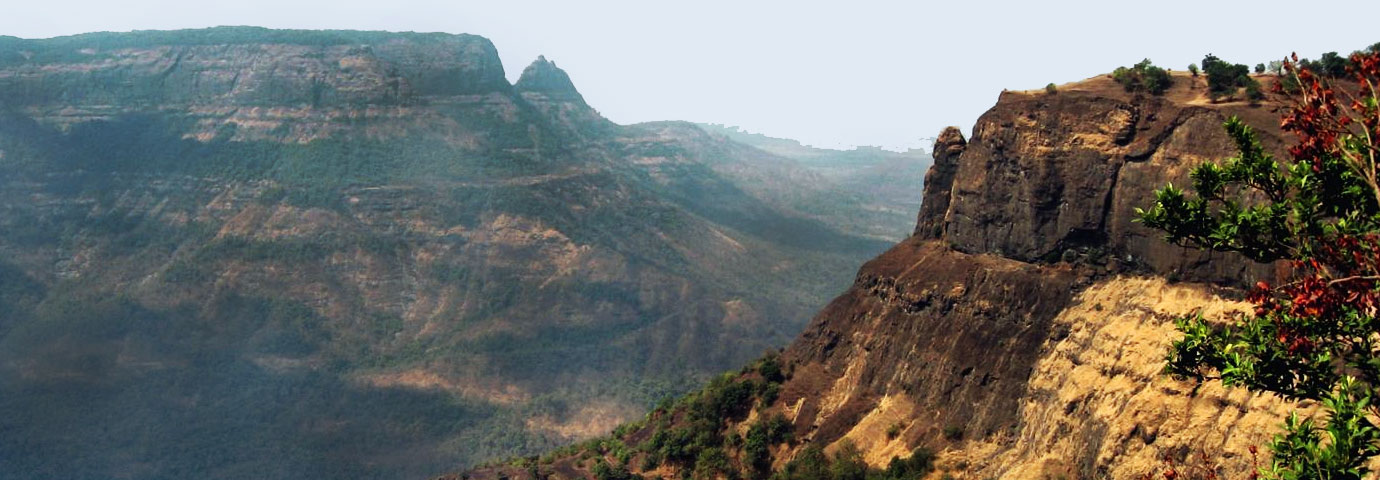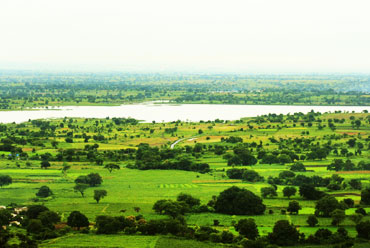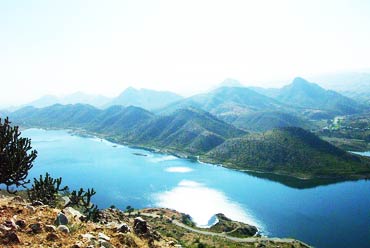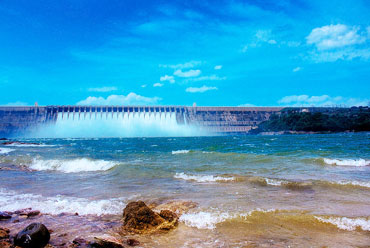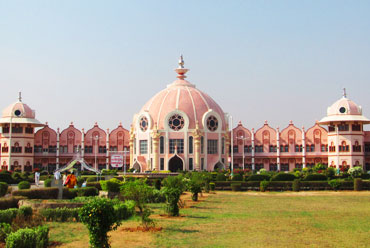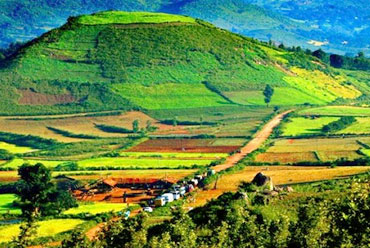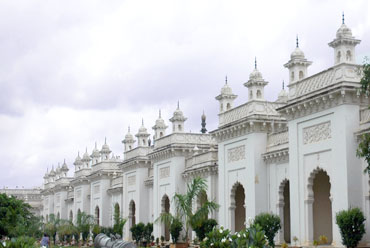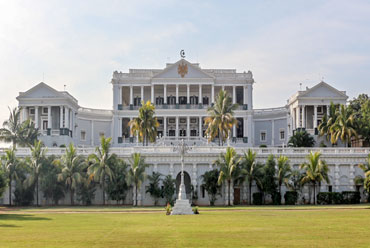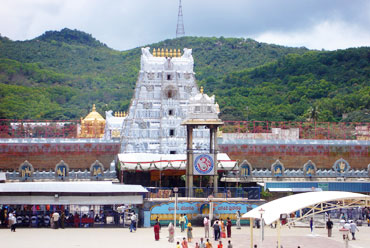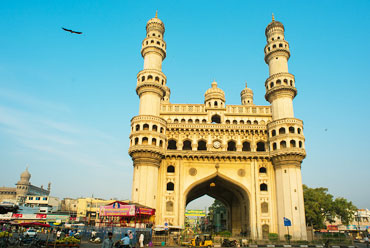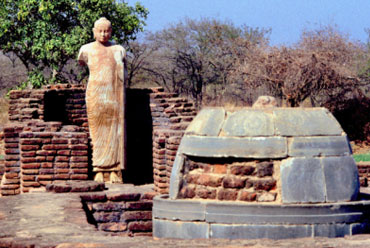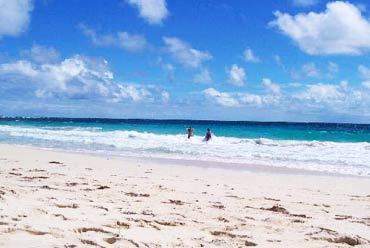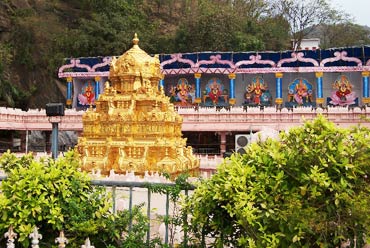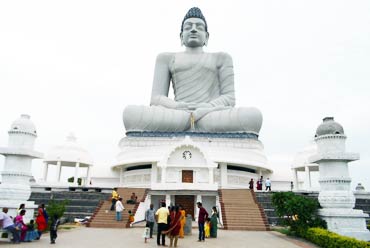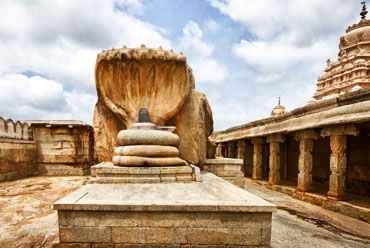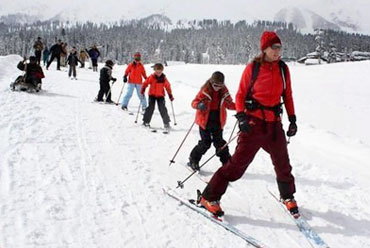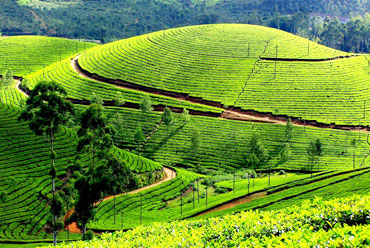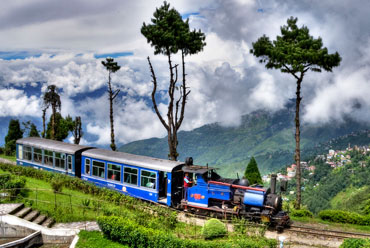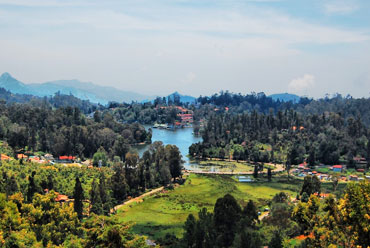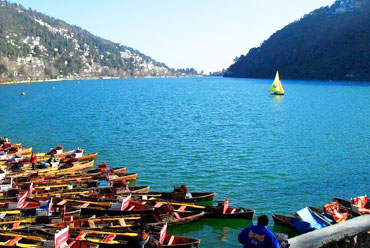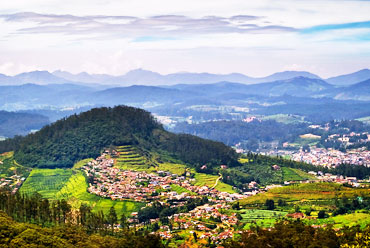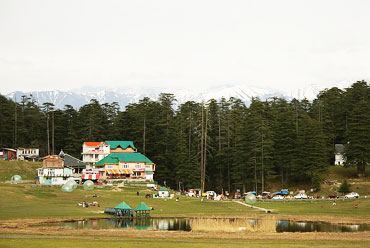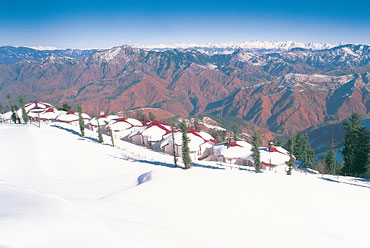The Deccan plateau is a topographically variegated region located south of the Gangetic plains-the portion lying between the Arabian Sea and the Bay of Bengal-and includes a substantial area to the north of the Vindhya Range, which has popularly been regarded as the divide between northern India and the Deccan. The name derives from the Sanskrit daksina ("south"). The plateau is bounded on the east and west by the Ghats, while its northern extremity is the Satpura Mountain Range. The Deccan's average elevation is about 2,000 feet (600 m), sloping generally eastward; its principal rivers, the Godavari, Krishna, and Cauvery, flow from the Western Ghats eastward to the Bay of Bengal. The plateau's climate is drier than that on the coasts and is arid in places. Although sometimes used to mean all of India south of the Narmada River, the word Deccan relates more specifically to that area of rich volcanic soils and lava-covered plateaus in the northern part of the peninsula between the Narmada and Krishna rivers.
Having once constituted a segment of the ancient continent of Gondwanaland, this land is the oldest and most stable in India. The Deccan plateau consists of dry tropical forests that experiences only seasonal rainfall
On the western edge of the plateau lie the Sahyadri, the Nilgiri, the Annamalai and the Cardamon Hills, commonly known as Western Ghats. The average height of the Western Ghats, which run along the Arabian Sea, goes on increasing towards the south. Anaimudi Peak in Kerala, with a height of 2,695 m above sea level, is the highest peak of peninsular India. In the Nilgiris lie Ootacamund, the well-known hill station of southern India. The western coastal plain is uneven and swift rivers flow through it that forms beautiful lagoons and backwaters, examples of which can be found in the state of Kerala. The east coast is wide with deltas formed by the rivers Godavari, Mahanadi and Kaveri. Flanking the Indian peninsula on the western side are the Lakshadweep Islands in the Arabian Sea and on the eastern side lies the Andaman and Nicobar Islands in the Bay of Bengal.
The eastern Deccan plateau, called Telangana, is made of vast sheets of massive granite rock, which effectively traps rainwater. Under the thin surface layer of soil is the impervious gray granite bedrock. It rains here only during some months.
Comprising the northeastern part of the Deccan Plateau, the Telangana Plateau has an area of about 148,000 sq km, a north-south length of about 770 km, and an east-west width of about 515 km.
The plateau is drained by the Godavari River taking a southeasterly course; by the Krishna River, which divides the peneplain into two regions; and by the Penneru River flowing in a northerly direction. The plateau's forests are moist deciduous, dry deciduous, and tropical thorn.
Most of the population of the region is engaged in agriculture; cereals, oilseeds, cotton, and pulses (legumes) are the major crops. There are multipurpose irrigation and hydroelectric-power projects, including the Pochampad, Bhaira Vanitippa, and Upper Penneru. Industries (located in Hyderabad, Warangal, and Kurnool) produce cotton textiles, sugar, foodstuffs, tobacco, paper, machine tools, and pharmaceuticals. Cottage industries are forest-based (timber, firewood, charcoal, bamboo products) and mineral-based (asbestos, coal, chromite, iron ore, mica, and kyanite). There is a dense network of roads, as well as railways and waterways; Hyderabad, capital of Andhra Pradesh, is linked by air with major cities in India. The language of the plateau is Telugu of the Dravidian family. The plateau's important cities and towns are Hyderabad, Warangal, Kurnool, and Nizamabad.
THE DECCAN TRAP
The northwestern part of the plateau is made up of lava flows or igneous rocks known as the Deccan Trap. The rocks are spread over the whole of Maharashtra and parts of Gujarat and Madhya Pradesh, thereby making it one of the largest volcanic provinces in the world. It consists of more than 2,000 m of flat-lying basalt lava flows and covers an area of nearly 500,000 sq km in west-central India. Estimates of the original area covered by the lava flows are as high as 1.5 million sq km. The volume of basalt is estimated to be 512,000 cubic km. The thick dark soil (called regur) found here is suitable for cotton cultivation.
History
The Deccan plateau is a land rich in history. The plateau's mineral wealth led many lowland rulers, including those of the Mauryan (4th-2nd century bc) and Gupta (4th-6th century ad) dynasties, to fight over it. The Satvahanas (28 bc-ad 250) emerged as an independent power in the Deccan in the first century bc. South of the Satvahanna kingdom, three dynasties emerged. These were the Cholas of Tanjore; the Pandyas centered in Madurai, and the Cheras along the Malabar Coast. The Cheras, Cholas and Pandyas appear to have been continually at war with each other. Cultural interaction between these kingdoms and the north exposed the rest of India to the rich Sangam literature of south.
The Satvahanas, Pallavas, Eastern Chalukyas, Kakatiyas, and the Vijaynagar kings successively ruled the region until it became part of the Qutub Shahi kingdom of Golconda. It later came under the rule of the Nizam Shahi dynasty of Hyderabad. Since the establishment of the Indian Union in 1947, there have been repeated demands for the creation of a Telangana state, separate from Andhra Pradesh.
The people of the south knew religious ideas from the north, such as the worship of the Vedic gods and the doctrines of Buddhism and Jainism. Some of them followed these religions, but most people still worshipped their gods and goddesses and practiced their own religious ceremonies.
St. Thomas is said to have come to India to spread Christianity in the first century ad. It first spread among the people of the Malabar Coast and in areas near present-day Chennai.
Tourists Attractions
Aurangabad
Named after the Mughal emperor Aurangzeb, Aurangabad is located in Maharashtra. It is globally renowned for the Ajanta and Ellora caves, apart from the Bibi-ka-Maqbara (mausoleum of Aurangzeb's wife) and the Aurangabad caves. Make Travel Plans with Aurangabad Tour Packages
Badami
The erstwhile capital of the Chalukyas, Badami is now a small rural town in Karnataka. It is best known for its beautiful cave temples, cut into the cliff face of a red sandstone hill. Explore Badami Tour Packages
Bangalore
Also in Karnataka, Bangalore is India's garden city. It boasts of some pleasant parks and historical monuments. Modern-day Bangalore has made great strides in the information technology revolution and is home to many multinational software companies. Plan a Trip With Bangalore Tour Packages
Belgaum
This small town in Karnataka is famous for its Jain temples and the Masjid Sata mosque. The Watchtower and Sunset Point offer panoramic views of the flat countryside and distant hills.
Bidar
The one-time capital city of the Bahamani rulers of south India, Bidar, located in Karnataka, is known for its historical monuments. The main tourist attraction of Bidar is its fort, built by Ahmad Wali Shah There are important palaces within the ramparts of the fort, including the Rangin Mahal, the Solah Kambh Masjid (16-pillared mosque), the Gagan Mahal, the Diwan-e-Am, the Royal Pavilion, and the Takhat Mahal.
Bijapur
The capital city of the Adil Shahi rulers of medieval India, Bijapur is situated in the southern state of Karnataka. It is known for its historical monuments. The magnificent Gol Gumbaz (the largest dome in India and the second largest in the world), the Ibrahim Roza (a beautiful tomb built by Adil Shah II for his queen), and the ruins of Gagan Mahal are worth seeing. The Sat Manzil (seven-storied palace), Jala Manzil (water pavilion), Bara Kaman (twelve arches), Taj Bawdi (water tank), Upli Burj (watch tower), Mehtar Mahal and Asar Mahal are other important places to visit in Bijapur.
Calicut
Calicut (also Kozhikode), located in Kerala, has been a commercial trading city since ancient times. Vasco-da-Gama landed in a place called Kappad close to Calicut in 1498. The city is the center of the timber industry, and is known for its boat building. The word 'calico' is derived from the name of this place. Explore Calicut Tour Packages
Gulbarga
Located in the Indian state of Karnataka, the small town of Gulbarga is famous for its association with the erstwhile medieval kingdom of Bahamani. A number of monuments dating from 13th to the 15th century can be seen here. Gulbarga fort is an important tourist spot. It fort includes the Jama Masjid, said to have been built by a Moorish architect from Spain in the late 14th century on the lines of the great Cordoba Mosque in southern Spain. Other places of interest within the town are the imposing tombs of the Bahamani rulers, the Haft Gumbaz, the tomb of Khwaja Bande Nawaz (an important local Muslim saint) and the Sharana Basaveshwara temple. Explore Gulbarga Tour Packages
Hampi
Located in the central part of Karnataka, Hampi is a world heritage site famous for its ruins belonging to the erstwhile kingdom of Vijaynagar. The temples and monolithic sculptures and monuments, along with the rugged landscape attract tourists to Hampi. Explore Hampi Tour Packages
Hassan, located in Karnataka, is the headquarters of Malanad district. The original town was adjacent to the Channapatna village. Channa Krishnappa Naik, a Palegar, founded it in the 11th century. The place is called Hassan after the Goddess "Hasanamba," the presiding deity of the town. The temple of Hasanamba is opened only once in a year during the second Ashwayuja (October). A big jatra (fair) is held on this occasion. Hassan is a convenient base for visiting the other temple towns close by, namely, Belur, Halebid and Sharavanabelagola. Shravanabelagola is a famous Jain pilgrimage with a 17-m-high monolith of lord Bahubali. Belur was once the capital of the Hoysala kings. The Chennakeshava temple took 103 years to be completed and is filled with intricate carvings and sculptures. Halebid, like Belur, is a mute testimony to the rich cultural heritage of Karnataka.
Hyderabad
Built around the Hussain Sagar Lake, Hyderabad is the capital of the state of Andhra Pradesh. It was founded in the 16th century by Mohammad Quli Qutub Shah and later became the seat of the fabled Nizams. Symbolic of Hyderabad is its Char Minar, a charming rectangular building with four slender minarets. Other places worth visiting include the Mecca Masjid, Salar Jung Museum, Birla Mandir, and Mahakali Temple. The Golconda Fort, the 13th-century fort rebuilt by the Qutub Shahi rulers, lies at a distance of 13 km from Hyderabad. Explore Hyderabad Tour Packages
Mysore and Bangalore are often referred to as twin cities. Being home to the royalty for centuries, Mysore has a number of palaces, parks and boulevards as well as museums and cultural centers. The Maharaja's Palace, Lalitha Mahal, Jayachamarajendra Art Gallery, Jaganmohan Palace, Chamarajendra Zoological Gardens, Rail Museum, St. Philomenas Church, etc. are some of the must-see places of Bangalore. Among the nearby places, Chamundi Hill (13 km), Srirangapatnam (16 km), Ranganathittu Bird Sanctuary (16 km), and Krishnasagar Dam (19 km) are worth visiting. However, the piece-de-resistance for many tourists visiting Mysore is the Vrindavan Gardens.
Ooty
Situated amidst the blue mountains of the Nilgiris in Tamilnadu, Ooty is an erstwhile British township and a popular hill station. The beautiful Botanical Gardens, Ketty Valley, Araku Valley, the Wenlock Downs and Doddabetta Peak are worth seeing. Browse Customize Ooty Tour Packages

